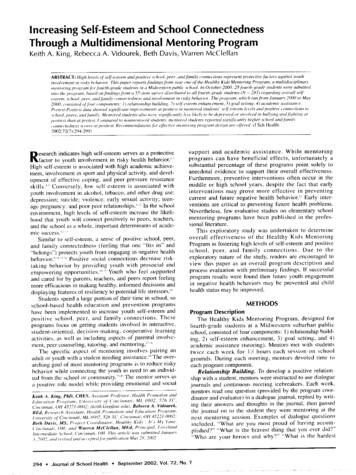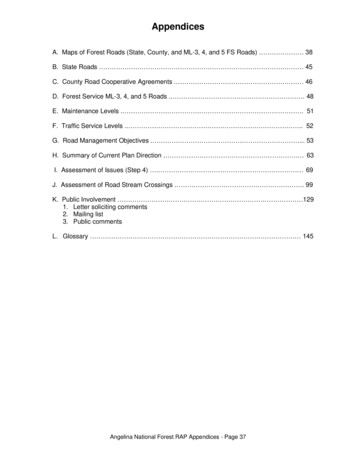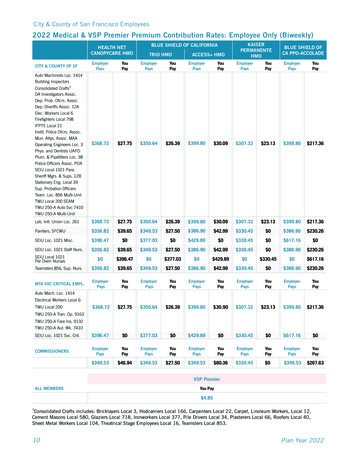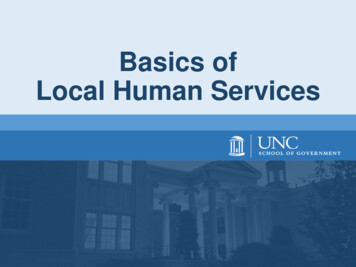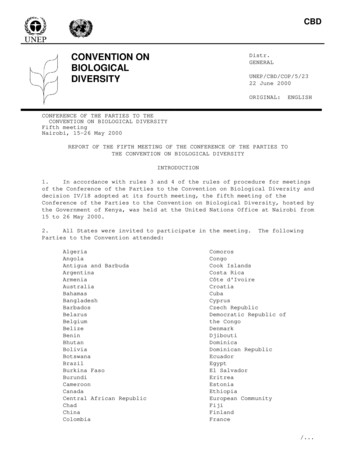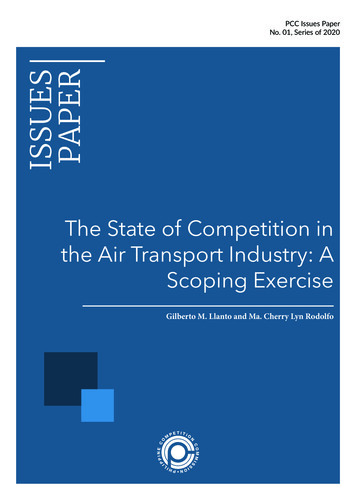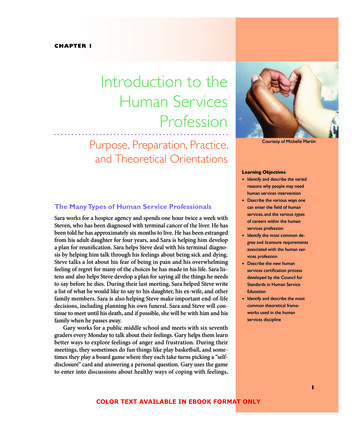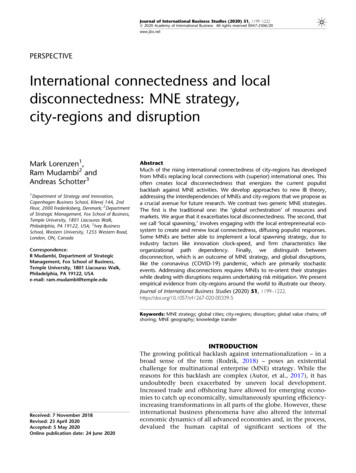
Transcription
Journal of International Business Studies (2020) 51, 1199–1222ª 2020 Academy of International Business All rights reserved 0047-2506/20www.jibs.netPERSPECTIVEInternational connectedness and localdisconnectedness: MNE strategy,city-regions and disruptionMark Lorenzen1,Ram Mudambi2 andAndreas Schotter31Department of Strategy and Innovation,Copenhagen Business School, Kilevej 14A, 2ndFloor, 2000 Frederiksberg, Denmark; 2 Departmentof Strategic Management, Fox School of Business,Temple University, 1801 Liacouras Walk,Philadelphia, PA 19122, USA; 3 Ivey BusinessSchool, Western University, 1255 Western Road,London, ON, CanadaCorrespondence:R Mudambi, Department of StrategicManagement, Fox School of Business,Temple University, 1801 Liacouras Walk,Philadelphia, PA 19122, USAe-mail: ram.mudambi@temple.eduAbstractMuch of the rising international connectedness of city-regions has developedfrom MNEs replacing local connections with (superior) international ones. Thisoften creates local disconnectedness that energizes the current populistbacklash against MNE activities. We develop approaches to new IB theory,addressing the interdependencies of MNEs and city-regions that we propose asa crucial avenue for future research. We contrast two generic MNE strategies.The first is the traditional one: the ‘global orchestration’ of resources andmarkets. We argue that it exacerbates local disconnectedness. The second, thatwe call ‘local spawning,’ involves engaging with the local entrepreneurial ecosystem to create and renew local connectedness, diffusing populist responses.Some MNEs are better able to implement a local spawning strategy, due toindustry factors like innovation clock-speed, and firm characteristics likeorganizational path dependency. Finally, we distinguish betweendisconnection, which is an outcome of MNE strategy, and global disruptions,like the coronavirus (COVID-19) pandemic, which are primarily stochasticevents. Addressing disconnections requires MNEs to re-orient their strategieswhile dealing with disruptions requires undertaking risk mitigation. We presentempirical evidence from city-regions around the world to illustrate our theory.Journal of International Business Studies (2020) 51, 39-5Keywords: MNE strategy; global cities; city-regions; disruption; global value chains; offshoring; MNE geography; knowledge transferReceived: 7 November 2018Revised: 23 April 2020Accepted: 5 May 2020Online publication date: 24 June 2020INTRODUCTIONThe growing political backlash against internationalization – in abroad sense of the term (Rodrik, 2018) – poses an existentialchallenge for multinational enterprise (MNE) strategy. While thereasons for this backlash are complex (Autor, et al., 2017), it hasundoubtedly been exacerbated by uneven local development.Increased trade and offshoring have allowed for emerging economies to catch up economically, simultaneously spurring efficiencyincreasing transformations in all parts of the globe. However, theseinternational business phenomena have also altered the internaleconomic dynamics of all advanced economies and, in the process,devalued the human capital of significant sections of the
International connectedness and local disconnectednessMark Lorenzen et al.1200population (Mudambi, 2018). Not surprisingly,many of these advanced economies have witnessedrising political instability, populism, and emergingprotectionism (Pastor & Veronesi, 2019; Witt,2019).Limiting our main analysis to the context ofadvanced economies, we make two fundamentalarguments in this paper. First, MNE strategies havebeen a significant part of the ongoing process ofglobal restructuring, resulting in their becomingthe targets of populist wrath in recent years. MNE’sgrowing location portfolios are designed to strategically leverage the rising knowledge intensity ofthe global economy (Mudambi, 2008). Therefore,the strategy of these firms is not exogenous to localdevelopment (Beugelsdijk, McCann & Mudambi,2010; Kano, 2018), but has almost always activelyharmed the interests of low-knowledge, low-skillworkers in advanced economies. Second, we positthat, rather than being passive objects buffeted bythis challenge, MNEs can design their strategies tocounteract it. In order to do so, they need torecognize the adverse local effects of their operations in the regions in which they locate. They canthen dynamically leverage and actively co-createlocation-specific advantages. These may appear inthe form of country-specific advantages (CSAs)(Rugman & Verbeke, 2001a). Perhaps more importantly, they also need to recognize that they mayadversely influence the regions in which theylocate and that they have the means to amendthese effects.MNEs are likely to meet opposition if theiractivities are perceived to immiserate sections ofthe population in the locations where they operate.Hence, we propose that IB’s traditional cross-borderobjects of analysis – location choice, entry mode,and governance – need to be complemented withnew theory that incorporates the fact that, to agrowing extent, MNEs’ very survival depends onthe interdependencies between their local engagement and regional development on the one handand their cross-border activities on the other(Cantwell, Dunning & Lundan, 2010; Cano-Kollmann, et al., 2016).1Traditionally, IB has related CSAs to nationalcompetitiveness, and consequently focuses its analysis of the location choice of MNEs at the nationallevel, e.g., institutions like law, education (especially university systems), economic policies, andpolitical systems. However, national competitiveness is increasingly based on sub-national economic systems (Scott & Storper, 2003). One long-Journal of International Business Studiesstanding conceptualization of such systems is thatof the city-region, i.e., a functional economic spaceconsisting of a core city and its surroundinggeographical catchment area for labor and services,comprising smaller cities and towns (Park, et al.,1925; Dickinson, 1947; Berry, 1973). While theresearch tradition of economic geography hasstudied city-regions for more than a century (Geddes, 1915; Cheshire, 1990; Parr, 2005), the concepthas not yet received much attention in IB (for selectexceptions, see Goerzen, et al., 2013; Stallkamp,et al., 2018; Blevins, et al., 2016; Ma, Delios & Lau,2013; Ma, Tong, & Fitza, 2013). We argue that thislimits the advance of MNE theory. MNEs oftenlocate in populous city-regions and typicallychoose these regions’ core cities, given their poolsof skilled labor and the proximity of technologyassets (Scott, 2001; Mudambi, 2008). However, wesuggest that such focused MNE entry affects thedevelopment of the city-region asymmetrically,and sometimes exacerbates the decline in theregion’s catchment area. The reason is that, whileMNEs create international connectedness betweenthe city-regions in which they locate, they alsoimpact their local connectedness, for good or ill.Given current steep declines in spatial transactioncosts,2 international connectedness is on the rise(Pearce, 1999). Hence, to a growing extent, itconditions the development of city-regions.In this paper, our preliminary step is to analyzelocal connectedness in city-regions in economic,social, and political dimensions. Our focus here ishow catchment areas are connected to core cities.Catchment areas are typically characterized bysmaller cities dominated by traditional, less knowledge-intensive activities (e.g., low-skill, labor-intensive manufacturing) and agricultural towns thathave depended on reciprocal trade relationshipswith the core city. This connectedness has been amajor source of economic opportunities in catchment areas.The next step constitutes the heart of our analysis, examining how this traditional internaldynamic of city-regions is impacted by MNE activity and strategy. First, we examine MNE activity inthe form of international connectedness and developthe paper’s first proposition. Core cities typicallyderive a much greater share of their value creationfrom knowledge-intensive production and R&Dactivities; their labor force is continuouslyupskilled, and they attract highly skilled labor fromabroad (Goerzen, et al., 2013). That makes corecities attractive for MNE investments that directly
International connectedness and local disconnectednessMark Lorenzen et al.1201or indirectly create specialized knowledge-intensivebusiness services. The result is that firms in corecities – MNEs as well as the network of domesticfirms that they work with – now increasingly serveglobal value chains, to the detriment of local valuechain relationships and services for local manufacturing firms in catchment areas. At the same time,core cities increasingly rely on foreign imports ofconsumer goods and foods rather than on theproducts of traditional local manufacturers andagriculture. As the local value chain relationships ofincreasingly knowledge-intensive core cities dwindle, the smaller cities and towns in their catchmentareas need to renew their local connectedness. Ifthey do not, their economic opportunities willdecline relative to core cities, centralizing wealthand population there. The result will be risinginequality between catchment areas and core citiesthat often brings about social as well as politicalinstability.In the second step of our analysis, we examineMNE strategy. We argue that the uneven distribution of economic opportunities within city-regionsas a result of international connectedness is notinevitable. Whether catchment areas become disconnected or can renew their local connections tocore cities is influenced by MNEs’ strategies of localengagement. We develop two generic MNE strategiesthat give rise to two propositions that capture whatwe argue is the central choice for today’s MNE:whether or not they complement their rationalization of global value chains with activities stimulating new local connectedness by becoming part oflocal entrepreneurial ecosystems.We propose that the traditional MNE strategyfocused solely on global orchestration will contribute to replacing local with international connectedness, and hence be associated with risinglocal inequality. In contrast, we propose a novelstrategy that we call local spawning which willcontribute to the renewal of local connectednessthrough active engagement with the local startups.We define an MNE’s local spawning activities asthose that create and develop the firm as the hub ina local entrepreneurship ecosystem. It entails anactive engagement with the local entrepreneurshipcommunity through a variety of modalities. Incontrast to scalable efficiency as the main objectiveof global value chain orchestration, local spawningseeks scalable learning, and, in the most generalterms, it involves value chain experimentation.A knowledge-seeking MNE that complements itsglobal orchestration activities with local spawningmay leverage new local connectedness as an openinnovation strategy. By exploring suppliers andtalent in catchment areas, it will benefit its ownperformance and drive local economic development. In the process, it will create a tighter fitbetween its firm-specific advantages (FSAs) and thelocational advantage of the relevant city-region.Thus, international connectedness may forge newtypes of local connectedness, contributing to developing polycentric city-regions, with secondary corecities, new technology clusters, and thriving residential satellites (Ganau-Casas, 2014; Hall & Pain,2006, Scott, 2001). In such city-regions, newdisseminated economic opportunities serve tolower the risk of policy backlash againstinternationalization.Finally, we link our analysis to the skepticismtoward globalization that has been rising over thepast decade (Cuervo-Cazurra, et al. 2017) and,therefore, the limits to what MNE strategy canachieve. This serves to precisely delineate thesubject matter of this paper. Our focus is on globalconnectedness and local disconnectedness that arethe direct outcomes of MNE actions and, therefore,can be ameliorated by strategy re-orientation. Incontrast, global disruptions like the coronavirus(COVID-19) pandemic are exogenous shocks thataffect local economies but do not arise from MNEactivity per se. We carefully distinguish between‘disconnectedness’ and ‘disruptions,’ but emphasize that our paper, in the main, addresses theformer.The interdependencies of MNE strategy and thewider development of city-regions is a question ofgreat relevance for not just the development oftheory in a range of fields but also local policymakers and MNE executives making innovation strategy and location choice decisions. In order toprovide IB with the power to theorize this question,the article incorporates ideas from economic geography, since a central theoretical stronghold in thisdiscipline is the nature and development of cityregions. While the article remains conceptual, inorder to illustrate the concerned phenomena andeffects, it draws upon illustrative empiricalmaterial.LOCAL CONNECTEDNESS: CITY-REGIONSCity-regionsCities, their associated economic activity, and theirrole as knowledge hubs, have been central toJournal of International Business Studies
International connectedness and local disconnectednessMark Lorenzen et al.1202economic geography research for more than acentury. Geography scholars have always recognized that economic activity and knowledge aredistributed unevenly over geographic space. In theearly years of the research tradition, the focus wason understanding how land use, rent, and costspatially segregated geographies into dense, profitable, and expensive urban areas, and progressivelyless productive and cheaper surrounding spaces(von Thünen, 1826). Later, economists joinedgeographers to analyze the nature of the economicactivity agglomerating in urban areas. Marshall(1920), often considered the originator of thetheory of economic clusters, pointed out that citiesare not merely population centers, as they alsoharbor clusters of related industrial activities andtheir associated labor markets. This conceptualization of clusters has since been refined with analysesof universities and other knowledge institutionsand supporting regulatory institutions (Anderson,1994; Feldman, 1994; Steiner, 1998; Scott, 2006;Youtie & Shapira, 2008). As noted by Storper andWalker (1989), the economic activities in citiesgenerate a supporting business and cultural environment of urban amenities, cultural diversity, andcreative milieus (Florida, 2002; Sassen, 2018).Taken together, these lead to a virtuous cycle ofgrowth fueled by continually attracting highlyskilled labor. One overarching finding of this lineof research is that economic outcomes are alsounevenly distributed: some cities develop strongerclusters, higher-class amenities, and institutions,and attract more highly skilled labor than others(Hill and Brennan, 2000; Goerzen, et al., 2013).Economic geographers also identified the fundamental urban forms arising in these heterogeneousgeographical spaces. Remaining primarily focusedonly on advanced economies (Robinson, 2002),this theorizing began with the theory of centralplaces. Beginning with the observation that alocation’s ability to offer amenities and serviceshinges upon its population size, Christäller (1933)suggested that urban ‘‘places’’ offer services andamenities to their own population as well as to thepopulations of smaller places in their surroundingareas (‘‘hinterlands’’), resulting in a hierarchy ofcities, towns, and villages.3 This first conceptualization of cities as functional systems (Berry, 1973)gave rise to the notion of city-regions, i.e., regionswith a large core city with functional relationshipswith its surrounding region of smaller cities andrural areas. These served as a geographical catchment area for the core city’s services and amenities,Journal of International Business Studiesand travel-to-work commuting. Whereas catchment areas emerge organically, political boundariesand policies often align with and reinforce them(Park, et al., 1925; Dickinson, 1947; Berry, 1973).4Sitting at the top of the regional urban hierarchy,the core city contains a wide array of servicescollocated in a central business district, surroundedby concentric circles of manufacturing activitiesand residential suburbs (Park, et al., 1925), sometimes interspersed with sectors of specialized manufacturing (Hoyt, 1939). Later, as populations grewand manufacturing industries changed, the modelof city-regions was amended. Industrial productionthat was not cost-efficient to be located in the corecity shifted outwards. This model can still be seenin the layout of core cities like Chicago in the firsthalf of the twentieth century (Chicago ZoningCommission, 1922). During the last half of thetwentieth century, the growth and sprawl of majormetropoles prompted geographers to further adjustthe model, acknowledging both a more extensiveand more diverse core city with different types ofresidential zones, transport corridors, and pocketsof new industries. Concomitantly, the newer models incorporated the emergence of manufacturingclusters and residential satellites in smaller cities incatchment areas (Henderson & Castells, 1987;Agnew & Duncan, 1989; Soja, 2014; Knox, 1993).Local ConnectednessThe fundamental driver of the development ofcatchment areas has always been their local connectedness to the core city in their region. In theearliest models of functional city systems, largelyagricultural catchment areas were in copious reciprocal exchange relationships with core cities. Thecatchment area supplied food, raw materials, andoften a commuting labor force, while the core wasthe location of high-knowledge services, amenities,and the associated jobs. As manufacturing industries grew, city-regions became more complex, buttheir fundamental local spatial connectednessretained the interdependence of catchment areasand core cities. The former supplied manufacturedgoods, components, and later also residential housing stock, while the latter provided services and,increasingly, specialized jobs.Thus, in the economic dimension, we may distinguish between three types of local connections.First, dominant in the pre-industrial age, but stillrelevant, is trade relationships between local agricultural producers and suppliers of services andmanufactured goods. Second, growing since
International connectedness and local disconnectednessMark Lorenzen et tween local supplier and buyer firms. Third, withthe rise of the knowledge economy, local knowledge-intensive economic connections have grownin importance, such as local R&D outsourcing andinnovation projects and alliances between increasingly specialized and knowledge-intensive localfirms.These types of economic connectedness have arange of economic benefits. Value chain relationships are associated with external scale economiesin terms of flexibility, efficiency, and user-producerlearning (Maskell & Malmberg, 1999; Lorenzen,2007). Knowledge spillovers between diverse butrelated industries, so-called ‘‘Jacobs externalities’’(Jacobs, 1969), may propagate new forms of innovation (Boschma & Iammarino, 2009). Finally,across a city-region, the dense, diverse, and shiftingrelationships between suppliers, buyers, and otherstakeholders may give rise to an entrepreneurialecosystem. Together with conspicuous local entrepreneur role models, spillovers of knowledge of theentrepreneurial process (Delgado, et al., 2010), andshared entrepreneurial mindsets and norms (Malecki, 2018), the presence of local investors andincubators may serve to significantly lower thebarriers to new firm entry (Spigel, 2017).Local connectedness also has a political dimension. Conscious of the economic connectedness ofthe city-region, local stakeholders often align interests in order to support it. The provision of power,communication, and transport infrastructures connecting firms in different industrial zones, as well aspublic education, is crucial for the functioning oflocal clusters and local value chains. Local politicalinstitutions (mayor’s offices, city councils) are alsoimportant stakeholders in local entrepreneurialecosystems, providing requisite policy (tax incentives, zoning) and public goods (education, trainingprograms) that strengthen entrepreneurial mindsets) (Malecki, 2018).Local policies may also serve to connect a cityregion in the social dimension, across differentsocietal groups and strata. A city-region with stronglocal connectedness will employ different types andlevels of skills within local value chains. Local labormarket policies (sometimes public, sometimesnegotiated between employers and unions) mayensure a continued local diversity of skills throughsustainable wage levels for all groups of skillholders. In well-developed city-regions, stakeholders also negotiate to facilitate differentiated residential zones for different wage-groups, as well aslocal transport infrastructures facilitating commuting to work and access to services.Figure 1 sums up the argument of localconnectedness.Distribution of Economic OpportunitiesLocal connectedness in economic, political, andsocial terms is associated with regional development, not just in terms of the average wealth of acity-region but also in terms of its internal distribution of economic opportunities. Extant researchpoints out that the latter is a more useful measureof local development than the distribution ofabsolute wealth (such as earnings). While the latterwill more often than not be unevenly distributed,whether wealth inequality will give rise to politicalinstability relates to the distribution of opportunities for increased earnings, upskilling, starting upone’s own enterprise, and access to affordableservices and housing (Bourguignon, 2015; OECD,2018).Local connectedness has important effects onhow economic opportunities are distributed in acity-region. Local trade between agricultural producers and suppliers of services and manufacturedgoods benefits both parties. Since the former arechiefly located in the catchment area and the latterin the core city, such local trade is a long-standingway of disseminating economic opportunity geographically. Local value chains disseminate gainsfrom trade from exporting firms to local suppliers.In early industrialization, such value chain relationships were often confined to industrial clustersin core cities and adjacent suburbs. However, asmanufacturing in most city-regions shifted outward from the core to smaller cities during thesecond half of the twentieth century, value chainrelationships were established between catchmentareas and core cities. A particular form of suchconnectedness, on the rise during the last decades,is that between the increasing scale of manufacturing plants in smaller cities in catchment areas(Duranton and Puga, 2005) and headquarters andbusiness services in core cities (ÓhUallacháin andLeslie, 2007). The result of these types of economicconnectedness is not just disseminated opportunities for employment of manufacturing and agricultural skill-holders in the catchment area andknowledge-intensive skill-holders in the core citybut also, as mentioned, external scale and knowledge spillovers to the benefit of firms in thecatchment area as well as in the core city. Relatedly,when a local entrepreneurship ecosystem grows outJournal of International Business Studies
International connectedness and local disconnectednessMark Lorenzen et al.1204Figure 1 Local connectedness in a city-region: economic, social, and political local dimensions.of local economic connectedness between thecatchment area and the core city, it is likely todisseminate opportunities for new firms across thecity-region. In the political and social dimensions,local connectedness disseminates access to affordable housing, transportation, and services in dailylife. In the short term, this provides local transportinfrastructures facilitating commuting to workfrom the catchment area to the core city, andprovides catchment area residents access to highlyspecialized services in the core city (Florida andFeldman, 1988). In the longer term, it also disseminates opportunities for upskilling and gainingJournal of International Business Studiesaccess to political representation to residents acrossthe city-region.While early city-regions were focused aroundagriculture and traditional manufacturing, the riseof the knowledge economy is transforming thelocal economic landscape virtually everywhere.Economic connections, as well as industrial clusters, are becoming increasingly knowledge-intensive, the former as R&D outsourcing and alliances,the latter as technology clusters (Scott, 2001;Mudambi, 2008). Local policies are refocused toserve such types of connections and clusters,investing in university education and research,
International connectedness and local disconnectednessMark Lorenzen et al.1205public research, and supporting high-tech incubators. City-regions in advanced economies haveexperienced differing impacts of this shift upontheir geographical distribution of economic opportunities. In general, in most city-regions, theknowledge economy has stimulated boomingrural–urban migration and the rapid growth of corecities, resulting in urban sprawl and large conurbations. In some city-regions, such growth has alsodisseminated to catchment areas, giving rise to‘‘secondary cores’’ or technology clusters. However,such dissemination of economic opportunities hastypically been confined to particularly prosperouscity-regions with one or two smaller cities offeringhigh-level universities or amenities that are particularly attractive to highly-skilled labor (Hall andPain, 2006; Soja, 2014). For many other cityregions, the main effects have been a growingdisparity of economic opportunities between catchment areas and core cities.We argue that city-regions that experience such adisparity are characterized by growing local disconnectedness. With the rise of the knowledge economy, city-regions are increasingly attractive astargets for MNE investment (Balland, et al., 2018).We argue that MNEs exert a potentially crucialinfluence on local disconnectedness, and, hence,ultimately on the distribution of economic opportunities in the city-regions in which they locate.We now turn to an analysis of how this occurs.INTERNATIONAL CONNECTEDNESS: MNESInter-city ConnectednessWhile city-regions are densely connected locally,there has always been some extent of migrationbetween them, and many derive much value fromexports. Migration and trade create inter-city connections, of which we can identify two main types(Lorenzen & Mudambi, 2013). The most fundamental is person-based connections, such as familyrelationships, friendships, acquaintanceships, andincreasingly informal professional networks (offlineand online) between individuals living in differentcity-regions. Person-based inter-city connectionscan be maintained across geographical distancethanks to developments in communication andtransportation technologies (Agrawal, et al., 2006).Typically, individuals leverage the social proximityprovided by their relationships, as well as culturalsimilarities and shared ethnic backgrounds, to workin scientific teams or to explore entrepreneurialopportunities across the cities to which they areconnected (Saxenian, 2006). These activitiesinvolve the exchange of information, advice, andknowledge.The second type of inter-city connection isorganization-based. These include, of course,short-term value chain relationships, but organization-based connections may also entail higherlevels of involvement and mutual interdependencies, as in the case of strategic alliances, jointventures, and, ultimately, ownership. Such connections all span geographies through organizational units located in different city-regions(Bathelt, et al., 2004). Person-based and organization-based connections are intertwined. On the onehand, many person-based connections are createdby organizations that transfer personnel across cityregions. However, such individuals are not free toact autonomously within their employer organizations: governance and incentives are designed toalign personal decision-making with the strategy ofthe parent organization. On the other hand, organizations benefit from existing person-based connections and may hire individuals because of thevaluable inter-city connections they hold. Organization-based connections with higher levels ofinvolvement may even be designed based onpersonal relationships between an organization’semployees and residents in particular city-regions(Qiu, 2005; Saxenian, 2002; Zaheer, et al., 2009).International ConnectednessEven if much inter-city connectedness remainswithin the borders of nation-states, internationalconnectedness has grown dramatically over the lasthalf of the twentieth century. Person-based international connectedness has been growing, drivenby the increasing international mobility of bothunskilled workers and highly skilled and educatedprofessionals. While these increases have triggeredpopulist reactions, emerging employment opportunities across the globe have spurred firms toquietly advocate for continued free movement ofsuch professionals. Many such employment opportunities, including the transfer of personnel, aredriven by a particular type of organization-basedinternational connectedness that is at the heart ofthe IB research agenda, e.g., in MNEs. Arguably,leveraging international networks of ownership arethe raison d’etre for the existence of MNEs (Buckleyand Casson, 1976), and they do so partly asarchitects of global value chains, arising throughtheir fine-slicing and geographical disaggregationJournal of International Business Studies
International connectedness and local disconnectednessMark Lorenzen et al.1206of value chain activities, allo
Philadelphia, PA 19122, USA e-mail: ram.mudambi@temple.edu Abstract Much of the rising international connectedness of city-regions has developed from MNEs replacing local connections with (superior) international ones. This often creates local disconnectedness that energizes the current populist backlash against MNE activities.

